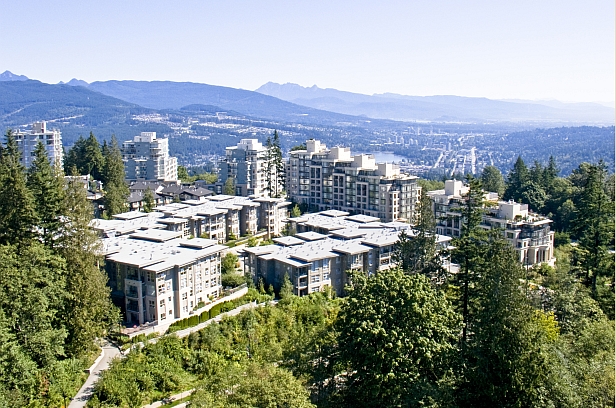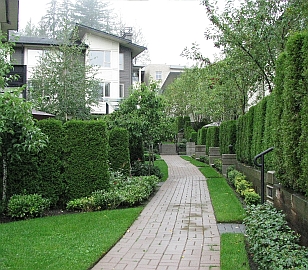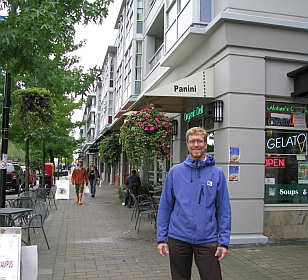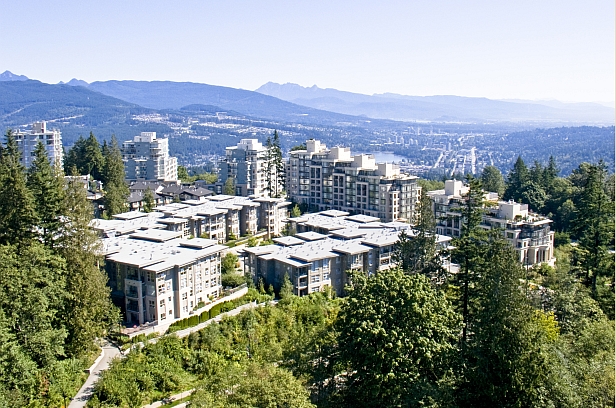 City-in-miniature on a hill: UniverCity, Burnaby, British ColumbiaPhoto: SFU Community Trust
City-in-miniature on a hill: UniverCity, Burnaby, British ColumbiaPhoto: SFU Community Trust
For the green benefits of urbanism — walkability, transit, smaller dwellings, more efficient buildings — to become a truly helpful climate strategy, we’re going to need them in more than just cities. We need suburbia to adopt those features too, because a full 50 percent of Americans live in suburbs (compared to 30 percent in central cities), according to 2000 census data.
With that in mind, I went to check out an experiment in suburban urbanism across the border in Burnaby, British Columbia, a suburb of Vancouver. Builders there are about one-third finished with UniverCity (forgive the awkward name), a planned neighborhood next to Simon Fraser University that’s borrowing some of the best traits of Vancouver’s planning successes and fitting them to a challenging location — a 1,200-foot hill.
At first approach, UniverCity looks like a medieval fortress-town. A ring of mid-rise condo towers sits atop a forested hill and you wonder why the site wasn’t developed sooner — it’s the highest point in the metro area outside the mountains, and on clear days it’s got stunning views of farmlands, the city, the Strait of Georgia, and the snow-capped North Shore Mountains.
 Outdoor pathways link yards in UniverCity’s Serenity townhouse development.Photo: Jonathan HiskesUp close, the neighborhood of 3,000 (so far) isn’t fortress-like at all. The building cluster includes a variety of forms — condo towers ranging from four stories to a planned 20-story tower at the highest point, single-family townhomes, and rental units above streetfront shops. First-floor dwellings have front doors and small yards rather than impersonal facades. Narrow streets slow down traffic. This being the Pacific Northwest, greenery sprouts from every soil patch and crevice in sight. Beautifully designed walkways and playgrounds give the sense that, rather than forgoing a suburban backyard, residents get an expansive, intricate yard to share.
Outdoor pathways link yards in UniverCity’s Serenity townhouse development.Photo: Jonathan HiskesUp close, the neighborhood of 3,000 (so far) isn’t fortress-like at all. The building cluster includes a variety of forms — condo towers ranging from four stories to a planned 20-story tower at the highest point, single-family townhomes, and rental units above streetfront shops. First-floor dwellings have front doors and small yards rather than impersonal facades. Narrow streets slow down traffic. This being the Pacific Northwest, greenery sprouts from every soil patch and crevice in sight. Beautifully designed walkways and playgrounds give the sense that, rather than forgoing a suburban backyard, residents get an expansive, intricate yard to share.
The project has a slew of smart energy and water-management features (to protect nearby salmon-bearing streams), but one accomplishment jumps out: By centering the neighborhood around outdoor spaces, an elementary school, and two daycare centers, planners have attracted more families with children than the regional average. That might be the most important story UniverCity has to tell, given the pervasive belief (at least in the U.S.) that urban neighborhoods are no place to raise kids.
I visited on a rainy weekday morning and didn’t get a good sense of how residents use the outdoor space in their off-time. But Sharilyn Wright, a graphic designer who runs an online store, told me it was the built design of UniverCity — plus the prohibitive price of Vancouver real estate — that drew her and her partner Charles to move there with their three-year-old daughter. “The lanes and pathways, for the most part, are safe and quiet, and children can play outside and ride their bikes,” she said in an email. “They have access to play a lot OUTSIDE in fields and forests … We loved that our daughter will be able to walk to school, just a few hundred meters from our door one day.”
 To the west lies Simon Fraser University and, in the distance, downtown Vancouver.Photo: SFU Community TrustA retail district includes a grocery, bank, and a handful of restaurants and shops, but the economic and cultural engine is the adjacent Simon Fraser University, a public school of 33,000 students and 3,300 staff. SFU’s private Community Trust began planning the neighborhood in the 1990s to build a community next to the car-dependent campus, create a model sustainable development, and generate money for the university.
To the west lies Simon Fraser University and, in the distance, downtown Vancouver.Photo: SFU Community TrustA retail district includes a grocery, bank, and a handful of restaurants and shops, but the economic and cultural engine is the adjacent Simon Fraser University, a public school of 33,000 students and 3,300 staff. SFU’s private Community Trust began planning the neighborhood in the 1990s to build a community next to the car-dependent campus, create a model sustainable development, and generate money for the university.
The Trust also worked with the province and the city of Burnaby to bring three facilities for young children to the hilltop. The first is a daycare center for 1- to 3-year-olds. Another daycare for 3- to 5-year-olds broke ground this fall, with plans to become Canada’s first Living Building, meeting an ambitious green standard much more stringent than LEED. It will use the Reggio Emilia early-education model, an approach that encourages children to learn by following their own interests and by exploring the physical world.
Then there’s the public elementary school, UniverCity Highlands. It opened this fall in a LEED Gold building with outdoor classrooms, a rooftop solar array, and a “litterless lunch” program. It’s also got touch-screen display in the lobby that lets students explore the school’s sophisticated energy and water systems.
“We’re looking at the building as a teacher of sustainability,” said Principal Lori Driussi.
She spoke of two factors that brought parents to the neighborhood — a desire for their kids to learn environmental values early on, and the astronomical prices of single-family homes in the Vancouver area. (It has the least affordable housing market among 272 major cities in Canada, the U.S., the U.K., Ireland, Australia, and New Zealand, according to a study this year.)
Wright agreed: “If you’re looking for more than a two-bedroom and don’t have a huge down payment, forget about it! … After almost a year or looking, out of desperation we began to look outside of the city — something we hadn’t even considered before … Somehow we came to look at a listing out here, and discovered UniverCity. We had no idea. I remember that day, we looked at six places and thought we could live in every one of them. It was a revelation.”
The project has a mixed record on addressing the affordability dilemma. The Trust has directed private developers to build in phases to induce demand, and units have sold briskly since the first project began in 2001. The Origin building, currently under construction, sold 33 of 75 condos within two months of opening its sales office in August, at prices from $298,000 to $609,000 ($292,000 to $597,000 USD), according to a sales representative.
 Planning manager Dale Mikkelsen was project planner for Vancouver’s Olympic village before coming to UniverCity.Photo: Jonathan HiskesBut the Trust knows those prices are out of reach for a lot of people, according to planning manager Dale Mikkelsen. When the neighborhood reaches an eventual population of 10,000, the plan is for even division between affordable, “moderate,” and market-rate units. So far, “it’s not as good as we want,” Mikkelsen said.
Planning manager Dale Mikkelsen was project planner for Vancouver’s Olympic village before coming to UniverCity.Photo: Jonathan HiskesBut the Trust knows those prices are out of reach for a lot of people, according to planning manager Dale Mikkelsen. When the neighborhood reaches an eventual population of 10,000, the plan is for even division between affordable, “moderate,” and market-rate units. So far, “it’s not as good as we want,” Mikkelsen said.
The 60 units of the Verdant building were sold to university staff at 20 percent below market rate. The Trust kept 140 units above the shops as rentals with affordability in mind — a 600 square-foot two-bedroom goes for about $1,200, Mikkelsen said.
The Trust takes another innovative approach to affordability through “flex suites” that buyers can purchase next-door to their main dwelling and rent as mortgage-helpers. If a family grows and needs extra space, the units are designed to allow a doorway to be added and the extra kitchen removed, for about $10,000. When kids grow up and move out, families can convert the suite back into a rental unit.
“The idea was how do you build a basement suite for an apartment owner, as a mortgage helper,” said Mikkelsen. It’s an idea that Victoria and Kelowna, B.C., have since adopted, he said.
Residents will also save on energy costs if they live in one of the newer buildings, which are developing centralized heating and district energy systems. The first towers, built in 2001, are not especially well-sealed, Mikkelsen said, so the Trust began offering a 10 percent density bonus to developers that better insulate their buildings. It’s an offer that’s been well-received, he said.
Residents might also save on transportation costs, since data shows that households in dense, walkable neighborhoods typically spend much less on getting around than families in auto-centric suburbs.
But UniverCity’s benefits are less clear in this regard because it sits atop Burnaby Mountain, surrounded by protected forest except for the SFU campus and two winding roads. In this way it resembles a gated subdivision more than a neighborhood woven into a metropolitan grid. While the grocery, stores, and campus provide a lot of nearby amenities, UniverCity is still too removed from the rest of the area to make car-free living practical, Wright said.
“Although I do know a (very small) handful or residents who don’t own a car, and I myself do not have a driver’s license, I would say that in reality most people have to have a car to live at UniverCity,” she wrote.
The Trust has focused on providing other options. Residents can buy regional transit passes at a steep discount, and developers are required to buy a year-long transit pass for each unit they sell, on the theory that if residents try using them, they’ll like it.
Buses run every few minutes from the SFU campus to a light-rail stations that connects to downtown Vancouver and Surrey, another employment center. Mikkelsen hopes to persuade the regional transit authority to build a gondola to run from the top of the hill to the rail station, shortening the trip from 14 minutes (by bus) to an estimated (and more scenic!) 7-minute gondola ride.
It’s a lot of effort to make up for the challenge of the hilltop location, and it builds the case that “destination accessibility” — building homes, workplaces, and services near each other in a well-connected grid — does more good than any particular amenity.
Mikkelsen, who was previously the lead project planner for the Olympic athletes’ village in Vancouver, said the Trust is willing to spend on transit because it’s trying to prove that compact urban forms can work outside of cities proper. Its work with Burnaby has helped convince zoning officials to allow denser development elsewhere in the town, he said. If the transit investment helps UniverCity convince the rest of the world that it’s possible to reap the benefits of urban design in a suburban setting, it could prove to be money well spent.



